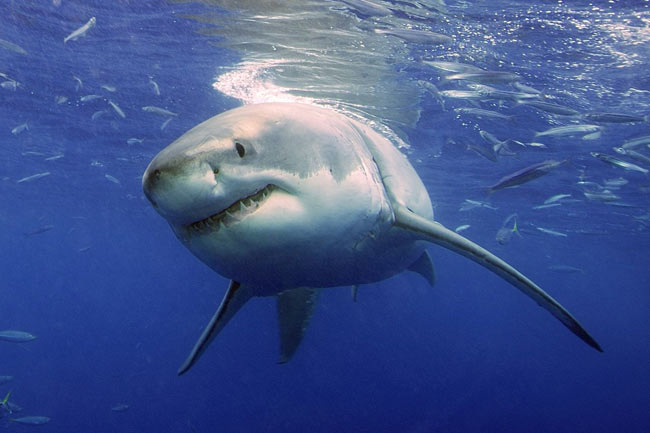Where Great White Sharks Lurk: Close to Home

Great white sharks tend to patrol specific neighborhoods for weeks on end, a new study finds.
And despite their ability to migrate thousands of miles, great whites in the Pacific were found to be a distinct genetic group compared with great whites elsewhere.
Sharks tagged with acoustic devices often spent up to 107 days at four key sites along the central and northern California coast where seals and sea lions are abundant: Southeast Farallon Island, Tomales Point, Año Nuevo Island and Point Reyes.
"The sharks were detected frequently at their chosen site," said Salvador Jorgensen, a postdoctoral researcher at Stanford University. This means "they are patrolling around there nearly constantly, for long periods of time. They will occasionally visit one of the adjacent sites, but they always come back."
The findings were published online Nov. 3 by the Proceedings of the Royal Society B.
Acoustic receivers detected five white sharks beneath the Golden Gate Bridge. There are no data to indicate how far the sharks crossed into the bay or why, but the researchers say it's likely they were hunting seals and sea lions in the region.
More broadly, the study revealed great whites spend the majority of their time in three areas of the Pacific: the North American shelf waters of California; the slope and offshore waters around Hawaii; and an area called the White Shark Café," in the open ocean about halfway between the Baja Peninsula and the Hawaiian Islands.
Get the world’s most fascinating discoveries delivered straight to your inbox.
"The thing we've learned about white sharks," said study co-author Scot Anderson, a marine biologist with the National Park Service, "is that they're not swimming around aimlessly — they are very selective predators."
The northeastern Pacific population may have been founded by a relatively small number of sharks in the late Pleistocene — within the last 200,000 years or so, genetic research shows. Other distinct other populations of white sharks are concentrated near Australia and South Africa.
"If you had asked us a few years ago, we would have said white sharks found in California probably migrated throughout the Pacific," said molecular geneticist Carol Reeb, a research associate at Stanford.
"Now, even though we know they travel great distances, their paths are surprisingly constrained to specific routes," Reeb said in a statement. "This explains how a highly migratory marine species becomes a genetically isolated population. This also makes it much easier to appreciate how vulnerable the northeastern Pacific white shark population could become if too many individuals were taken as either catch or bycatch, since these sharks do not appear to interbreed with other shark populations."
- Gallery: Great White Sharks
- Dangers in the Deep: 10 Scariest Sea Creatures
- On the Brink: A Gallery of Wild Sharks



